How to Store Fresh Herbs for Winter UK: Complete Preservation Guide
Discover professional techniques to preserve your fresh herbs through winter in the UK. From traditional air-drying to modern freezing methods, learn how to maintain flavour and nutrients in your homegrown herbs all year round.
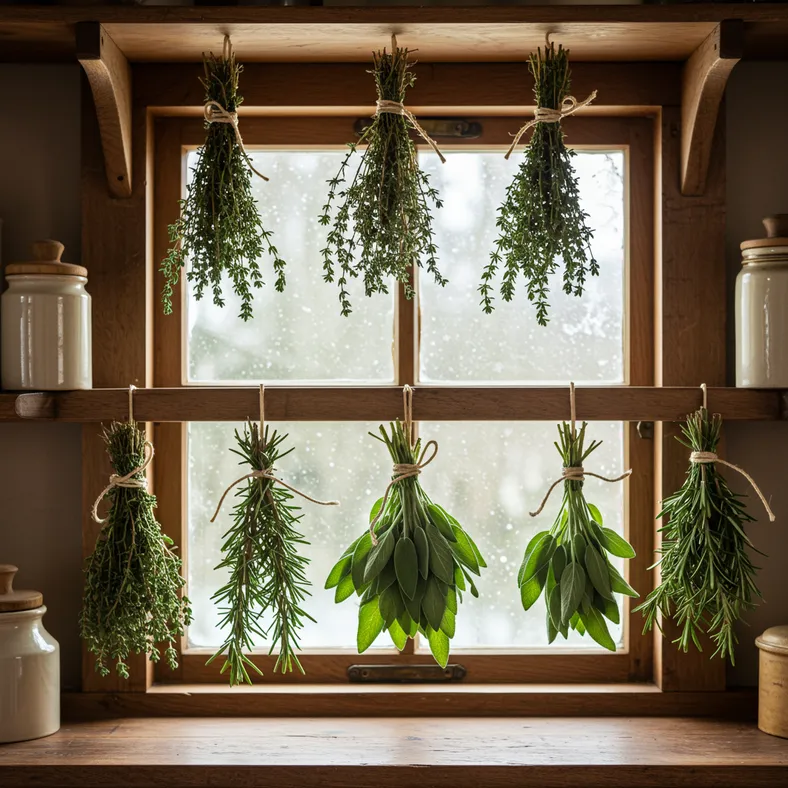
- When to Harvest Herbs for Winter Storage
- Air-Drying Herbs the Traditional Way
- Freezing Fresh Herbs for Maximum Flavour
- Creating Herb-Infused Oils and Vinegars
- Oven-Drying for Quick Results
- Using a Dehydrator for Professional Results
- Proper Storage Containers and Conditions
- Troubleshooting Common Storage Problems
- Maximising Herb Garden Productivity for Storage
As the UK's growing season winds down and the first frosts threaten your herb garden, preserving your harvest becomes essential for maintaining a year-round supply of flavourful herbs. Whether you've grown basil on a sunny windowsill or cultivated a full herb garden, proper storage techniques can extend your fresh herbs' life from weeks to months.
British gardeners face unique challenges when storing herbs through winter - from dampness that encourages mould to limited sunny drying spaces. This comprehensive guide covers proven preservation methods specifically tailored for UK conditions, ensuring you can enjoy the taste of summer herbs even during the darkest winter months.
When to Harvest Herbs for Winter Storage

Timing your herb harvest correctly is crucial for successful winter storage. In the UK, the optimal harvesting window typically falls between late August and mid-October, depending on your location and the specific herbs you're growing.
Best harvesting conditions:
- Pick herbs on a dry morning after the dew has evaporated but before the afternoon heat
- Choose stems just before the plant flowers for maximum oil content and flavour
- Harvest when plants are at their healthiest, typically mid-season growth
- Avoid picking herbs that are stressed, wilted, or showing signs of disease
For tender herbs like basil and coriander, harvest before the first frost warning. Hardy herbs such as rosemary, thyme, and sage can withstand light frosts but should be harvested before temperatures consistently drop below -5°C.
Regional timing considerations:
- Scotland and Northern England: Begin harvesting by early September
- Midlands: Harvest window extends to late September
- Southern England: Can harvest into early October
Always check your local weather forecast and plan to complete your harvest before any predicted hard frosts.
Air-Drying Herbs the Traditional Way
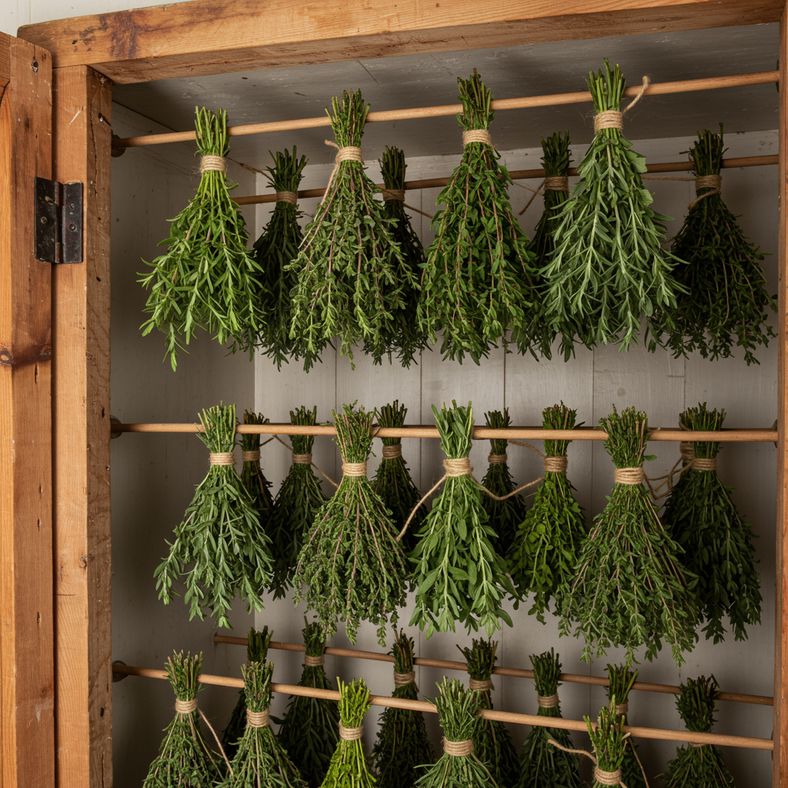
Air-drying remains the most popular method for preserving herbs in the UK, particularly suitable for woody herbs like rosemary, thyme, oregano, and sage. This traditional technique requires no special equipment and produces herbs that retain excellent flavour for up to two years when stored properly.
Step-by-step air-drying process:
- Prepare the herbs: Rinse harvested stems gently in cool water and pat completely dry with kitchen towel. Any remaining moisture will cause mould during the drying process.
- Bundle the stems: Group 6-8 stems together and secure with garden twine or elastic bands. Avoid making bundles too thick, as this prevents proper air circulation.
- Choose your drying location: Select a warm, dry area with good air circulation but away from direct sunlight. Ideal UK locations include airing cupboards, spare bedrooms, or covered outdoor areas like garden sheds.
- Hang to dry: Suspend bundles upside down from hooks or drying racks, ensuring bundles don't touch each other.
- Monitor progress: Most herbs will be ready in 1-2 weeks. They're properly dried when leaves crumble easily between your fingers.
UK-specific drying tips:
- Combat high humidity by using a dehumidifier in your drying space during particularly damp periods
- In flats or homes without suitable drying areas, create a makeshift drying space using a cardboard box with ventilation holes
- Avoid kitchens and bathrooms where steam and moisture levels fluctuate
Once completely dried, strip leaves from stems and store in airtight glass jars away from light. Label each jar with the herb name and drying date for best quality control.
Freezing Fresh Herbs for Maximum Flavour
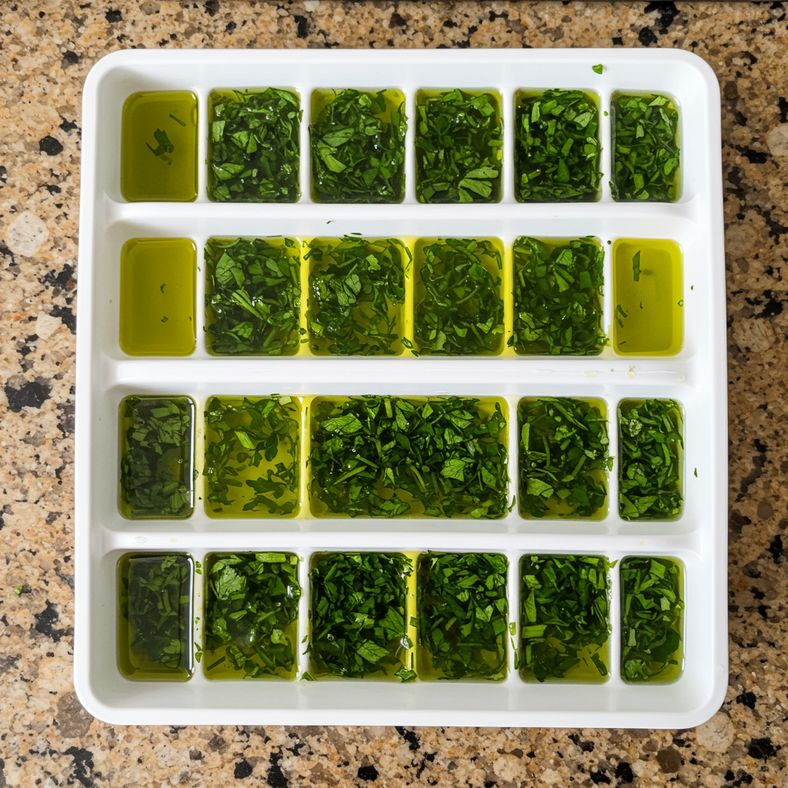
Freezing is ideal for soft-leaved herbs like basil, parsley, coriander, and chives that don't dry well. This method preserves both colour and flavour more effectively than drying, though the texture will change, making frozen herbs perfect for cooking but not garnishing.
Simple freezing method:
- Wash and dry thoroughly: Clean herbs under cold running water and spin dry in a salad spinner or pat dry with kitchen towel
- Remove tough stems: Strip leaves from thick stalks, keeping only tender stems
- Portion for convenience: Divide herbs into meal-sized portions before freezing
- Package properly: Place in freezer bags, removing as much air as possible, or use airtight containers
- Label and date: Frozen herbs maintain quality for 6-8 months
Ice cube method for convenience:
This technique is particularly popular with UK cooks for adding herbs directly to soups, stews, and sauces:
- Chop herbs finely and place in ice cube trays
- Add a small amount of water or olive oil to each compartment
- Freeze until solid, then transfer cubes to freezer bags
- Each cube contains approximately one tablespoon of fresh herbs
Special technique for basil:
Basil blackens when frozen using standard methods. To preserve its bright green colour:
- Blanch leaves in boiling water for 2 seconds
- Immediately plunge into ice water
- Pat dry and freeze as normal, or blend with a small amount of olive oil before freezing
Frozen herbs work exceptionally well in British comfort foods like shepherd's pie, casseroles, and herb-crusted roasts where texture isn't critical.
Creating Herb-Infused Oils and Vinegars
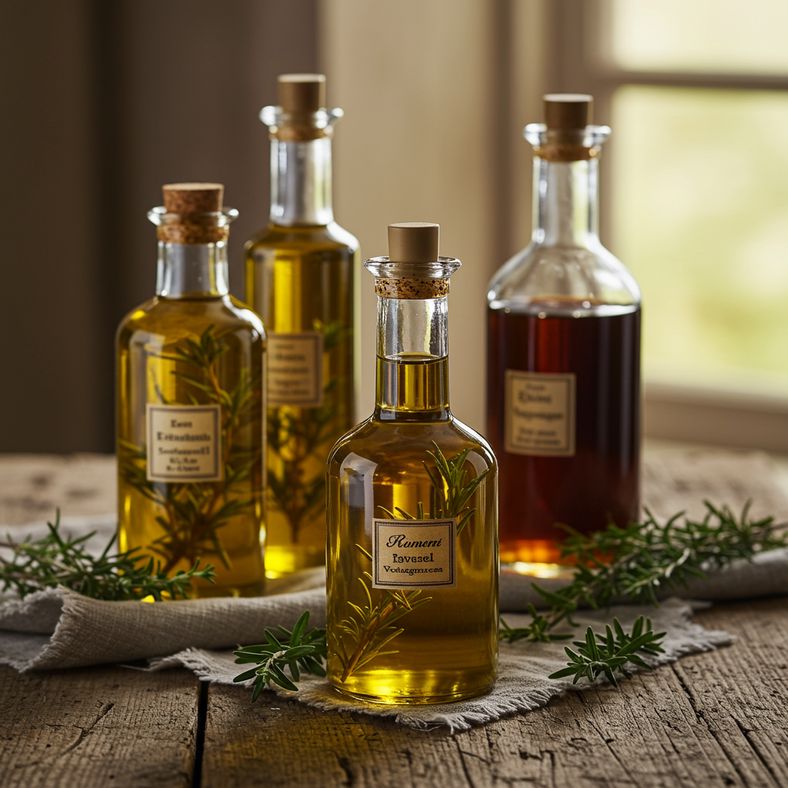
Herb-infused oils and vinegars offer a sophisticated way to preserve herbs while creating gourmet condiments perfect for British cooking. These preparations work particularly well with Mediterranean herbs like rosemary, thyme, and oregano that thrive in UK gardens.
Safety considerations for herb oils:
Raw herbs in oil can potentially harbour botulism, so proper preparation is essential:
- Always acidify fresh herbs before adding to oil
- Use citric acid (available from chemists) to create a safe environment
- Store finished oils in the refrigerator and use within 6 months
- Never leave herb oils at room temperature for extended periods
Safe herb oil preparation:
- Prepare citric acid solution: Mix 500ml water with 1 tablespoon citric acid granules
- Acidify herbs: Soak 250ml chopped fresh herbs in the solution for 24 hours at room temperature
- Drain and dry: Remove herbs, drain thoroughly, and pat completely dry
- Combine with oil: Mix acidified herbs with 1 litre good quality olive oil
- Infuse: Store in a cool, dark place for 7-10 days, shaking daily
- Strain and bottle: Remove herb matter and store in sterilised bottles in the refrigerator
Herb vinegar method (simpler and safer):
- Fill clean bottles with fresh herb sprigs
- Cover completely with white wine or cider vinegar
- Seal and store in a cool, dark place for 2-4 weeks
- Strain and rebottle with fresh herb sprigs for presentation
- Herb vinegars keep for up to one year in a cool pantry
Best herbs for infusions:
- Oils: Rosemary, thyme, oregano, sage
- Vinegars: Tarragon, basil, mint, chives
These infused preparations make excellent gifts and add restaurant-quality flavours to everyday British dishes like roasted vegetables, salad dressings, and marinades.
Oven-Drying for Quick Results
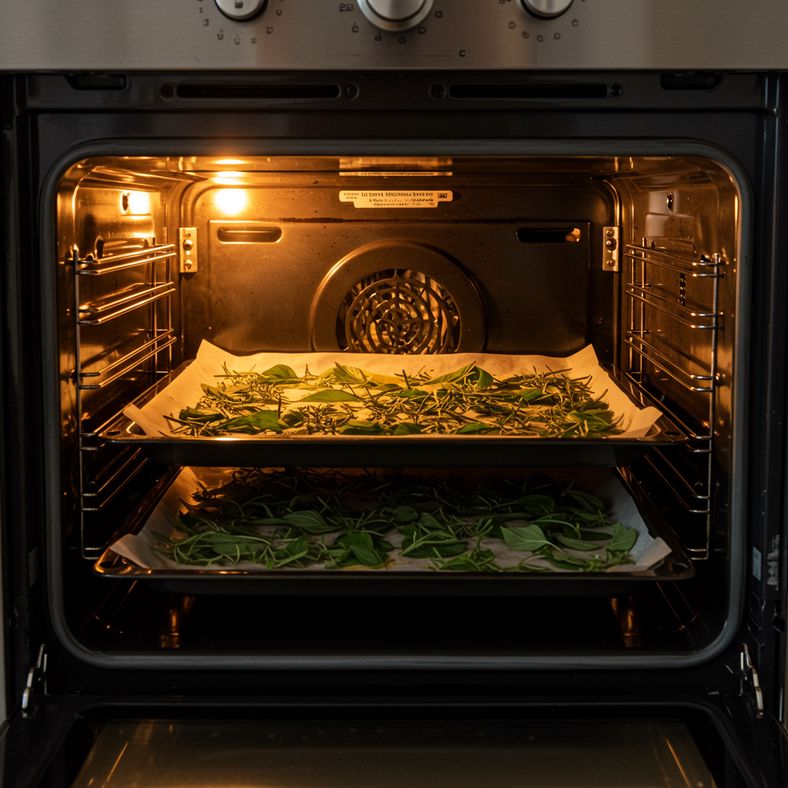
When time is short or weather conditions aren't suitable for air-drying, oven-drying provides a quick alternative that works well for most herbs. This method is particularly useful during Britain's unpredictable autumn weather when humidity levels fluctuate.
Oven-drying process:
- Preheat oven to lowest setting: Most UK ovens' minimum temperature is around 50-60°C, which is perfect for herb drying
- Prepare baking trays: Line with baking parchment or silicone mats
- Arrange herbs: Spread clean, dry herb leaves in a single layer, ensuring they don't overlap
- Prop oven door: Leave slightly ajar with a wooden spoon to allow moisture to escape
- Monitor closely: Most herbs will be ready in 2-4 hours, depending on thickness and moisture content
- Test for doneness: Leaves should crumble easily but not turn brown
Temperature and timing guide:
- Delicate herbs (basil, parsley): 35-40°C for 2-3 hours
- Medium herbs (oregano, thyme): 40-50°C for 3-4 hours
- Woody herbs (rosemary, sage): 50-60°C for 4-6 hours
UK oven considerations:
- Fan ovens dry herbs faster but may blow lighter leaves around - use a cooling rack over the herbs if necessary
- Gas ovens with pilot lights often provide perfect low-temperature drying conditions
- If your oven doesn't go low enough, try the warming drawer if available
Quality indicators:
- Properly dried herbs retain their colour and don't brown or blacken
- Leaves should feel papery and crumble when rubbed between fingers
- Avoid over-drying, which destroys essential oils and flavour
Store oven-dried herbs immediately in airtight containers to prevent moisture reabsorption during humid British weather.
Using a Dehydrator for Professional Results
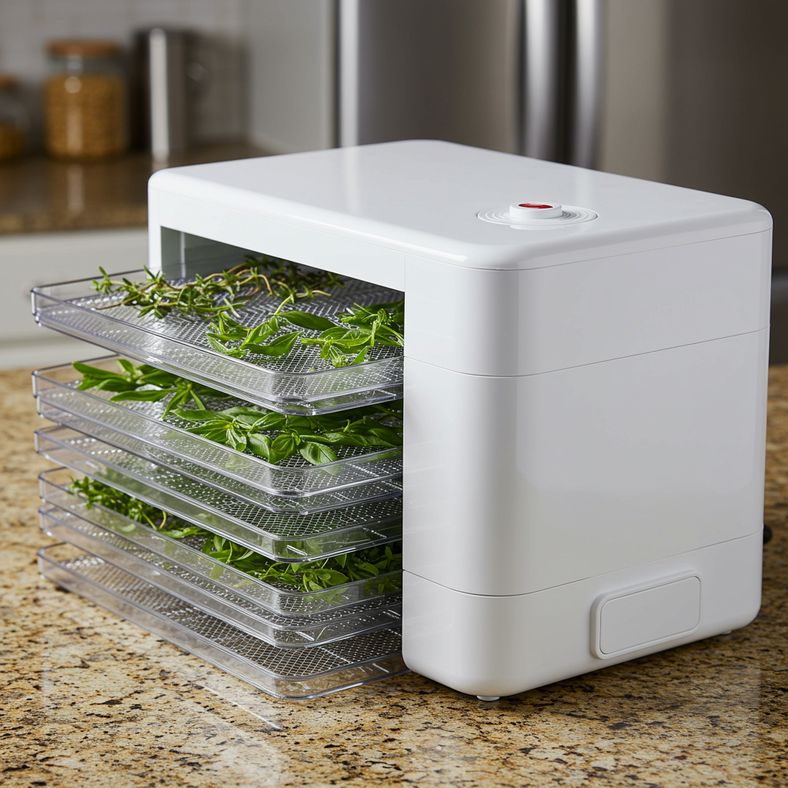
Electric dehydrators offer the most controlled environment for drying herbs, producing consistently high-quality results regardless of Britain's changeable weather. While requiring an initial investment, they're particularly valuable for serious herb gardeners who preserve large quantities annually.
Advantages of dehydrator drying:
- Precise temperature control prevents overheating and preserves essential oils
- Consistent airflow ensures even drying throughout
- Weather-independent operation - perfect for Britain's unpredictable climate
- Faster than air-drying (typically 6-12 hours vs 1-2 weeks)
- Can accommodate large quantities efficiently
Dehydrator herb drying process:
- Set optimal temperature: Use 35-40°C for most herbs to preserve maximum flavour and colour
- Prepare herbs: Wash, dry thoroughly, and remove thick stems
- Arrange on trays: Place in single layers without overlapping, using mesh sheets for small herbs
- Monitor progress: Check every 2-3 hours and rotate trays for even drying
- Test for completion: Herbs are ready when leaves crumble easily but stems still have slight flexibility
Recommended dehydrator features for UK use:
- Adjustable temperature control (30-70°C range)
- Timer function for convenience
- Multiple tray capacity for batch processing
- Quiet operation for home use
- Easy-clean removable trays
Herb-specific dehydrator settings:
- Basil, mint, parsley: 35°C for 6-8 hours
- Oregano, thyme, sage: 40°C for 8-10 hours
- Rosemary, bay leaves: 45°C for 10-12 hours
Dehydrators also work excellently for drying herb seeds like coriander and fennel, which are increasingly popular in British herb gardens. The controlled environment ensures seeds dry evenly without losing viability for next year's planting.
Proper Storage Containers and Conditions
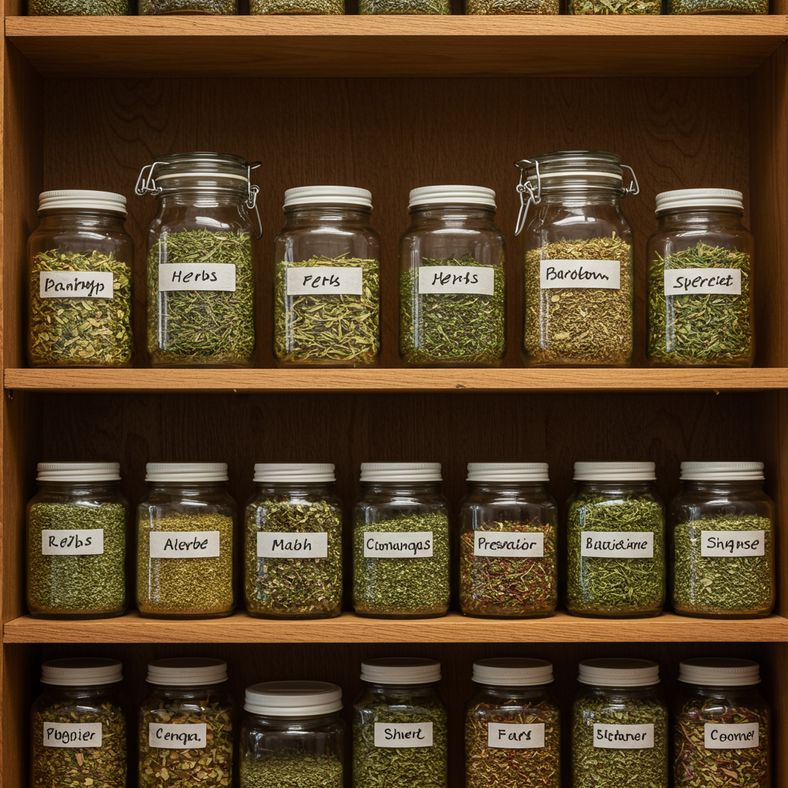
Even perfectly preserved herbs will lose quality quickly without proper storage. British homes face particular challenges with varying humidity levels and temperature fluctuations that can compromise stored herbs.
Best storage containers:
- Glass jars with airtight lids: Kilner jars or recycled spice jars work excellently and allow visual inspection
- Vacuum-sealed bags: Remove all air for maximum longevity
- Tin containers: Light-proof and airtight, perfect for long-term storage
- Avoid plastic containers: Can absorb herb oils and may not provide adequate air seal
Optimal storage conditions:
- Temperature: Cool and consistent, ideally 15-20°C
- Light: Store in dark cupboards or use opaque containers
- Humidity: Keep dry with silica gel packets if necessary
- Air exposure: Minimise by using appropriately sized containers
UK-specific storage considerations:
- Avoid storing near radiators or boilers where temperature fluctuates
- Kitchen cupboards above the cooker are too warm and humid
- Pantries and cool larders provide ideal conditions
- Consider using a dehumidifier in storage areas during damp winter months
Labelling system:
- Include herb name and preservation date
- Note preservation method (dried, frozen, oil-infused)
- Use within dates: dried herbs (2 years), frozen herbs (8 months), infused oils (6 months)
Quality maintenance tips:
- Check stored herbs monthly for signs of moisture or deterioration
- Use the oldest herbs first following a 'first in, first out' system
- Keep containers tightly sealed except when removing herbs
- Replace silica gel packets every 6 months in humid conditions
For serious herb preservation, consider investing in vacuum-sealing equipment. This removes all air from storage bags, significantly extending herb life and preventing freezer burn on frozen herbs.
Troubleshooting Common Storage Problems
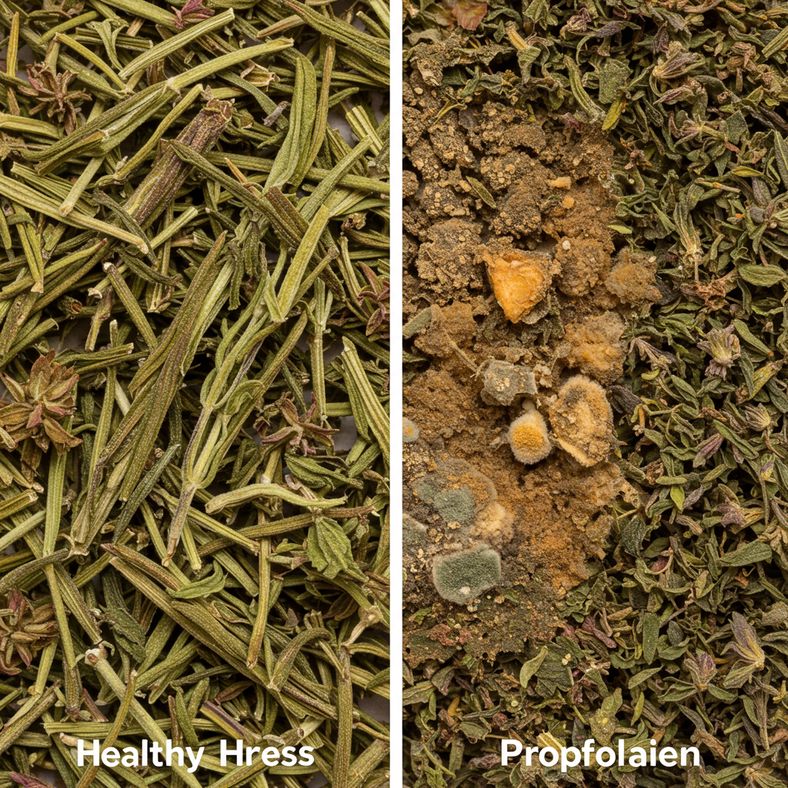
Even experienced gardeners encounter issues when preserving herbs. Understanding common problems and their solutions ensures successful herb storage throughout the British winter months.
Mould development during drying:
- Cause: Insufficient air circulation or herbs not completely dry before bundling
- Solution: Increase air circulation with fans, ensure herbs are thoroughly dry, and make smaller bundles
- Prevention: Choose drying locations with good airflow and avoid drying during very humid weather
Herbs losing colour and flavour:
- Cause: Exposure to light, heat, or air during storage
- Solution: Transfer to opaque containers and store in cool, dark locations
- Prevention: Use light-proof storage containers and maintain consistent cool temperatures
Freezer burn on frozen herbs:
- Cause: Air exposure in freezer packaging
- Solution: Repackage in airtight containers or vacuum-sealed bags
- Prevention: Remove as much air as possible before freezing and use appropriate freezer containers
Herbs becoming dusty or powdery:
- Cause: Over-drying or crushing during storage
- Solution: Store whole leaves when possible and crush only when ready to use
- Prevention: Monitor drying process carefully and handle dried herbs gently
Inconsistent drying results:
- Cause: Varying humidity, temperature, or herb preparation
- Solution: Standardise your preparation method and monitor environmental conditions
- Prevention: Keep detailed records of successful techniques and environmental conditions
UK weather-related challenges:
- High humidity periods: Use dehumidifiers in drying areas or switch to oven-drying methods
- Temperature fluctuations: Monitor storage areas and relocate herbs if necessary
- Limited drying space: Create makeshift drying areas using cardboard boxes with ventilation holes
Keep a simple log of your preservation attempts, noting methods used, environmental conditions, and results. This record becomes invaluable for perfecting your technique over successive seasons.
Maximising Herb Garden Productivity for Storage
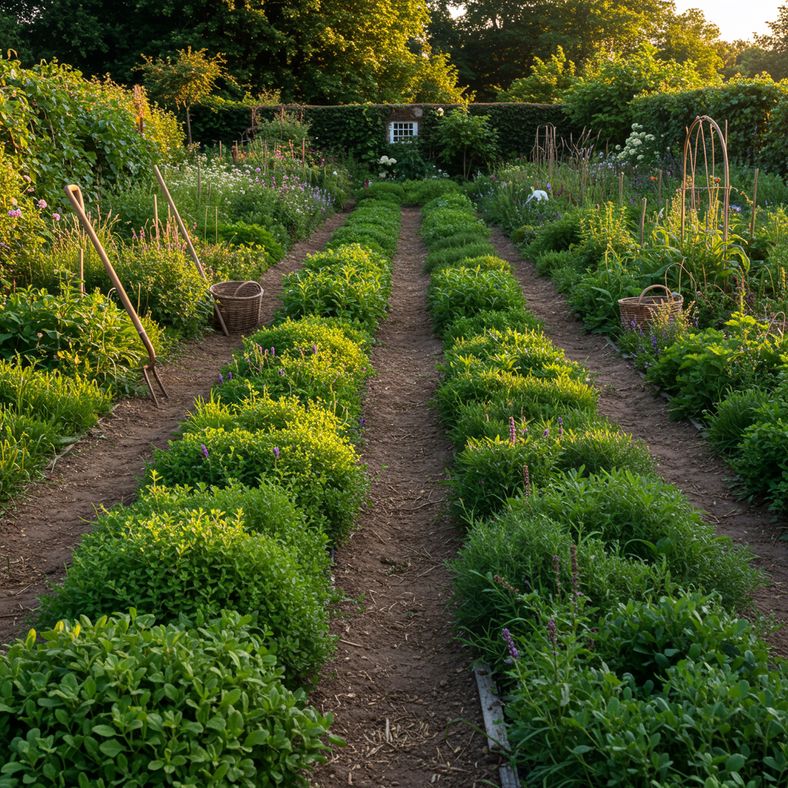
To ensure abundant herbs for winter storage, strategic planning and cultivation techniques can significantly increase your harvest yields. British gardeners can extend growing seasons and improve plant productivity with targeted approaches.
Succession planting for continuous harvest:
- Sow fast-growing herbs like coriander and parsley every 2-3 weeks from March through August
- This ensures fresh herbs for immediate use while allowing dedicated plants to mature for preservation
- Plant late-summer crops specifically intended for autumn harvest and storage
Choosing high-yield varieties:
- Basil: 'Genovese' and 'Sweet Basil' produce abundant large leaves perfect for preservation
- Parsley: Flat-leaf varieties generally yield more than curly types
- Coriander: Choose slow-bolt varieties for extended leaf harvest
For UK gardeners looking to expand their herb growing, quality seeds make all the difference. Consider exploring specialty varieties that thrive in British conditions while providing excellent storage characteristics.
Harvest timing for maximum yield:
- Regular harvesting encourages continued growth and prevents plants from going to seed
- Cut herb stems just above a leaf pair to promote bushy regrowth
- Take no more than one-third of the plant at any single harvest
Container growing advantages:
- Mobile containers can be moved to protected areas during early frosts
- Easier to monitor and control growing conditions
- Ideal for tender herbs that need protection in British winters
Extending the growing season:
- Use cloches or cold frames to protect plants from early frosts
- Grow tender herbs like basil in greenhouses or conservatories
- Bring container-grown herbs indoors for winter harvesting
Planning for preservation:
- Allocate specific plants for storage rather than harvesting randomly
- Allow preservation plants to grow larger before the final harvest
- Time final harvests to coincide with optimal preservation conditions
When planning your herb garden for storage, consider both your family's usage patterns and the preservation characteristics of different herbs. Some herbs like sage and rosemary store excellently when dried, while others like basil are better frozen or made into oils.